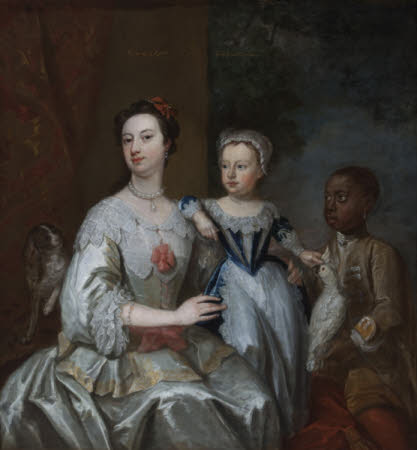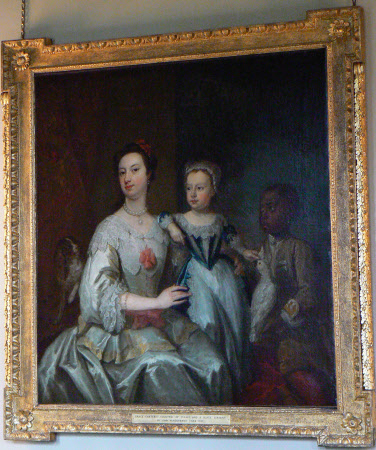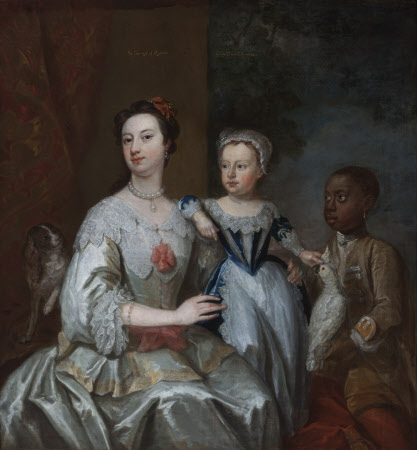Lady Grace Carteret, Countess of Dysart (1713-1755) with a Child (possibly Lady Frances Tollemache [1738 - 1807]) and an Unidentified Enslaved Child
Johann Aegidius Eckhardt (d.Chelsea 1779)
Category
Art / Oil paintings
Date
circa 1740
Materials
Oil on canvas
Measurements
1327 x 1235 mm
Place of origin
England
Order this imageCollection
Ham House, Surrey
NT 1139793
Summary
Oil painting on canvas, Lady Grace Carteret, Countess of Dysart (1713–1755) with a Child (possibly Lady Frances Tollemache [1738–1807]) and an Unidentified Enslaved Child by Johann Aegidius Eckhardt / John Giles Eccard (b. Germany, active in England c.1739, died Chelsea 1779), circa 1740. Painted inscriptions over Grace Carteret’s head: The Countess of Dysart and over the centre child’s head: Lady Grace Tollemache. A three-quarter-length portrait of a seated woman in a silvery-grey satin bodice and skirt, the bodice enlivened with yellow trim, pink ribbons, lace cuffs and collar. To the woman’s right stands a child, whole length, in a blue silk ‘Vandyke’ dress with a 'v' waist and an apron of fine lawn trimmed with lace; to the child’s right, an enslaved child, three-quarter-length, wearing an ochre-coloured livery coat and red breeches, a pearl drop earring and silver collar around his neck. At the far left a spaniel looks up at the seated woman, its left paw raised. The youngest child’s right elbow leans on her mother's shoulder and she holds the crest of a white cockatoo, which is supported by the enslaved child with his left hand.
Full description
Lady Grace Carteret, Countess of Dysart (1713–55) was daughter of the 2nd Earl of Granville, KG (1690–1763), a linguist, diplomat and politician. She was a talented amateur artist who painted pastel portraits of her family and decorated furniture with elaborate shellwork. In 1729, she married Lionel Tollemache, 4th Earl of Dysart (1708–70). Together they had sixteen children, eight of whom survived to adulthood. This group portrait of Lady Dysart, her child and an unidentified enslaved child dates to 1740. The artist, Johann Aegidius Eckhardt, was a German portraitist who arrived in England as a young man, possibly in 1739 with the French portraitist and subject painter, J.B. Van Loo (1684–1745). Eckhardt was assistant to Van Loo in London until the latter left England in 1742. Eckhardt found success in London, painting small-scale portraits in the style of Van Loo, although he also painted in the manner of Rubens and, as seen in this portrait, Van Dyck. During the eighteenth century, Van Dyck was revered by artists as a master and predecessor worthy of emulation. His style was particularly popular as a source for portraiture, as was the style of clothing worn by his sitters, known as ‘Vandyke’ dress. [1]. In Eckhardt’s portrait, the vogue for ‘Vandyke’ dress is apparent. Lady Dysart’s young child is depicted in ‘Vandyke’ fashion, wearing a dress of blue silk with an apron of fine lawn trimmed with lace. [2] Most striking is the resemblance between Lady Dysart’s clothing and jewellery to those worn by Queen Henrietta Maria in Van Dyck’s portrait of 1632 in the Royal Collection. Both wear a bodice and skirt of white satin with ‘carnation’ pink ribbons. Similarly, Lady Dysart’s pearl earrings and pearl necklace with a central pearl-drop pendant recall jewellery worn by Henrietta Maria and captured by Van Dyck. [3] Eckhardt’s portrait demonstrates Lady Dysart’s love of fine clothing, an interest that was remarked upon in her lifetime.[4] Surviving records also attest to Lord Dysart’s interest in fashion, detailing the great amounts he spent on his clothing and the clothing of his wife, children and servants. [5] It is also evident great expense was lavished on outfitting the enslaved child, dressed as a page, at far right. He wears a fine, ochre-coloured livery coat, red breeches and a pearl drop earring. A silver collar encircles his neck. It is not known if the enslaved child gazing at Lady Dysart was included by Eckhardt as a trope or as a portrait of a real individual. His presence references seventeenth-century court portraiture (and examples by Van Dyck in particular), in which Black figures are included as pictorial devices, from conferring status to the primary sitter and reflecting the theatricality of court life, to creating visual structures of white dominance. [6] This changes by the eighteenth century however, as representations of Black attendants, servants and enslaved peoples proliferated across all aspects of British visual culture, appearing not only in portraiture but in prints, shop signs, playing cards, as well as on ceramics, jewellery and silver. This proliferation of imagery coincides with the rapid intensification of British colonial activity and slave trading. In this way, by 1740, the presence of finely dressed Black attendants in European portraiture is inexorably linked to the enslavement and trafficking of African peoples occurring across the globe. That the Black child in Eckhardt's portrait is enslaved is made clear by the silver collar around his neck. [7] The wearing of silver collars may have sometimes been ‘ornamental’– an accessory akin to pearl earrings and white turbans which also appear in iconography of Black servants. Suspended from this collar, is a globe-shaped pendant, loosely painted. It may be a pearl, or bell or padlock. [8] (Gabriella de la Rosa, 2020) Notes [1] On ‘Vandyke’ dress see Aileen Ribeiro, ‘Some Evidence of the Influence of the Dress of the Seventeenth Century on Costume in Eighteenth-Century Female Portraiture’, The Burlington Magazine, Dec., 1977, Vol. 119, No. 897, pp. 834–40. [2] Aileen Ribeiro observes that ‘It is impossible to know who the child is and its gender. Small boys wore frocks until ‘breeched’ around the age of four, and “Vandyke” costume was particularly popular for boys in portraiture (and occasionally in real life); but the pointed waist and the neckline of the dress might suggest a female.’ See Aileen Ribeiro, ‘Elite Male Fashion in mid-eighteenth-century England: the Case of Lionel Tollemache, 4th Earl Dysart’ in Christopher Rowell, ed., Ham House: 400 Years of Collecting and Patronage, New Haven and London: Yale University Press, 2013, footnote 41, p. 308. [3] See Anthony Van Dyck, Queen Henrietta Maria (1609–69), before Aug 1632?, RCIN 404430. As part of her dowry Henrietta Maria brought a pair of large teardrop-shaped pearls, later known as the Mancini pearls. These may be the pearls worn by Henriette Maria in Van Dyck’s portrait and alluded to in Eckhardt’s portrait. [4] Lady Dysart’s cousin was Mary Delany, née Granville (1700–1788), the diarist and artist best known for her ‘paper mosaics’ now kept in the British Museum. Mrs Delany praised Lady Dysart’s looks and her clothes, describing her in 1734 as ‘handsomer than ever’ in ‘pink armazine trimmed with silver’ and in 1739 at a Court Ball wearing a ‘very fine and handsome’ scarlet damask gown and white satin petticoat, both ‘embroidered with gold and colours.’ Quoted in Christopher Rowell, ‘Lionel Tollemache, 4th Earl of Dysart, as a Collector and Patron’ in Christopher Rowell, ed., Ham House: 400 Years of Collecting and Patronage, New Haven and London: Yale University Press, 2013, p. 279. An earlier portrait (1737) of Lady Dysart by John Vanderbank (NT 1139647) also in the collection at Ham house, also demonstrates an interest in fine clothing. It seems to have been painted as a pendant to an earlier portrait by Vanderbank of Lord Dysart (NT 1139649) in red velvet coronation robes. The portrait of Lady Dysart depicts her similarly attired in the female version of these red velvet robes with an ermine fur cape. [5] Aileen Ribeiro writes: ‘The 4th Earl spent much on his appearance, and on his clothes especially in his younger years… Mercers’, drapers’ and tailors’ bills reveal the extent to which clothing underpinned status, but, although such expenses seem large, they would also have included fabrics also for the fashionable Lady Dysart, clothes for the children, liveries for the servants, and so on.’ See Aileen Ribeiro, ‘Elite Male Fashion in mid-Eighteenth-century England: The case of Lionel Tollemache, 4th Earl Dysart’ in Ibid., p. 306. [6] See for example Van Dyck’s Princess Henrietta of Lorraine, Attended by a Page, 1634 in the collection at Kenwood, English Heritage, 88022826. For more on the motif of Black attendants in European portraiture, see Peter Erickson, ‘Invisibility Speaks: Servants and Portraits in Early Modern Visual Culture’ in Journal for Early Modern Cultural Studies, Vol. 9, No. 1 (Spring–Summer, 2009); Paul Kaplan, ‘Italy, 1490-1700’ in Bindman and Gates (eds.), The Image of the Black in Western Art, from the ‘Age of Discovery’ to the Age of Abolition: Artists of the Renaissance and Baroque, vol. III, no. 1. Cambridge, Harvard University Press: 2010. [7] For more on the documentation of unwaged (and therefore enslaved) people in the seventeenth-century household of Ham House, see the Full Description for Lely’s portrait of Elizabeth Murray, Lady Tollemache, later Countess of Dysart and Duchess of Lauderdale (1626-1698) and an Attendant (NT 1139940). Ham House was connected to colonialism and the trade in enslaved peoples through Lady Dysart, who was a descendant of Sir George Carteret, early colonial proprietor in North America and the Bahamas and founder of the Guinea Company. See ‘Interim Report on the Connections between Colonialism and Properties now in the Care of the National Trust, Including Links with Historic Slavery’, https://nt.global.ssl.fastly.net/documents/colonialism-and-historic-slavery-report.pdf, eds. Sally-Anne Huxtable, Corinne Fowler, Christo Kefalas, Emma Slocombe, p. 73. [8] The addition of bells or padlocks to silver collars functioned as ‘a precaution against escape, for they were irremovable without a key and were usually inscribed with the owner’s coat-of-arms or address.’ David Bindman, ‘Subjectivity and slavery in portraiture’ in Slave Portraiture in the Atlantic World, eds. Agnes Lugo-Ortiz and Angela Rosenthal, Cambridge University Press, 2013, p. 75.
Provenance
In 1820 catalogue; and thence by descent until acquired in 1948 by HM Government when Sir Lyonel, 4th Bt (1854–1952) and Sir Cecil Tollemache, 5th Bt (1886–1969) presented Ham House to the National Trust, and entrusted to the care of the Victoria & Albert Museum, until 1990, when returned to the care of the National Trust, and to which ownership was transferred in 2002.
Credit line
Ham House, The Dysart Collection (purchased by HM Government in 1948 and transferred to the National Trust in 2002)
Marks and inscriptions
Painted inscription over Grace Carteret's head: The Countess of Dysart Painted inscription over the child's head: Lady Grace Tollemache Frame tablet: GRACE CARTERET, COUNTESS OF DYSART, AND A BLACK SERVANT / BY JOHN VANDERBANK (?1694 - 1730)
Makers and roles
Johann Aegidius Eckhardt (d.Chelsea 1779), artist British (English) School, artist previously catalogued as attributed to Bartholomew Dandridge (bap. London 1691 – London 1755), artist previously catalogued as attributed to William Hogarth (London 1697 - London 1764), artist


